





muestra
DUAL FOCUS
INDEX

1. How is our planet
2. A planet full of life
3. Microorganisms
Take action
• Focus on English
• 1 What are microorganisms?
• 3 Bacteria and their importance
• 2 Viruses and their importance
• 4. Protoctista and their importance
• 5 Fungi and their importance
• Final Challenge
4. Plants
5. Invertebrates
6. Vertebrates
7. Ecosystems
8. We use the resources of the planet
9. Towards sustainable development

Take action!

MICROORGANISMS
Viruses
can be have
Parasites
Living beings
Bacteria
Monera Prokaryotic
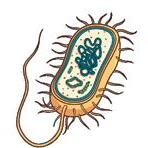
Protoctista

Eukaryotic. Unicellular or multicellular
Fungi Are not living beings






FOCUS ON E N GLISH 3 MICROORGANISMS
Eukaryotic Heterotrophic

Unicellular (yeasts)
Can you identify which microbe caused the disease?

SCAN THE CODE TO FIND OUT ABOUT THE CHALLENGE
General characteristics
Microscopic Simple Important






Protozoa. Unicellular and heterotrophic





Importance

Multicellular (moulds and fungi that form mushrooms)
Importance


Algae. Autotrophic







Listening and Speaking
Listen to the recording of the outline. Repeat the words to practise your pronunciation.
Reading and Writing
In your notebook, create your own outline. Use the information in the flipped worksheets at the end of this book to include more details.
25
Types Nutrition Interaction Reproduction Importance

What are microorganisms? 1
The definition of a microorganism
A microorganism is a microscopic living being. This means that we can only see it with a microscope.
The group microorganisms includes:

These are not living beings.

Microorganisms share these characteristics:


• They are microscopic. They measure less than 100 microns.
• Their biological organisation is simple. They are made up of one cell, very few cells or no cells (in the case of viruses).
• They perform the vital functions in a basic way. They also perform these functions differently. They can be autotrophs or heterotrophs; they can reproduce sexually or asexually; they can be mobile or immobile…
• They are resistant and adaptable. They can live in any environment.
• They are essential for life on Earth.
1 Reading. Read the information on the page. Then, copy and complete the sentences in your notebook.
a) ... are microorganisms but they are not living beings.
b) The kingdoms of living beings that include microorganisms are… .
c) Microorganisms measure less than … microns.
2 In your notebook, write the type of microorganisms shown in the photographs on the right.
3 How many cells do most microorganisms have?
Vocabulary
What is a microorganism?
What are the characteristics of microorganisms?
Which groups of living beings include microorganisms?




Microorganism, microscopic, microscope, micron, virus, monera, protoctista, fungi, biological organisation, vital functions, resistant, adaptable, essential.


26
VIRUSES BACTERIA PROTOCTISTA FUNGI
A C B D
Viruses and their importance 2

How viruses are like?
• Viruses have these characteristics:
• They have no cells. This means that they are not living beings.
• They are surrounded by a protein shell called a capsid. Their genetic material is inside.
• They are parasites. They invade cells and use them to reproduce.
Viruses and disease
Viruses cause diseases when they invade another living organism’s cells. The process is as follows.
• A virus enters a cell and its genetic material allows it to take control of the cell.
• It uses the parts of the cell to makes copies of itself.
• The invaded cell dies. The virus particles then propagate. This means that they spread to more cells.
Viruses cause diseases. The common cold, hepatitis, rabies and the flu are examples.


What are viruses?
Are they living beings?
Why/Why not? Why are they important?
Genetic material. Inside the capsid
Capsid. Formed of proteins
Types of capsids


Helical Spherical Icosahedral Icosahedral with a tail Tobacco mosaic virus Flu virus Hepatitis A virus Bacteriophage virus

1 Correct the sentences in your notebook.
a) Viruses are living beings.
b) Viruses have a capsid formed of DNA.
c) Viruses are carnivores because they feed on cells.
d) There are proteins inside the capsid of a virus.
2 Say yes or no.
a) Do viruses perform the three vital functions?
b) Do viruses have cells?
c) Do viruses have a capsid made of proteins?
d) Can viruses cause disease?
e) Is there only one type of capsid?
3 Speaking. Look at the pictures on the page. Write the shape of the capsids of these viruses.
a) Tobacco mosaic virus.
b) Flu virus.
c) Hepatitis A virus.
d) Bacteriophage virus.
4 Do some research. Explain how a virus infects a cell, how it makes copies of itself and how it propagates. Include drawings.
5 Writing. Write a sentence to answer this question: Why are viruses parasites?
Vocabulary
Virus, capsid, protein, genetic material, helical, spherical, icosahedral, tobacco mosaic virus, flu, hepatitis, bacteriophage, disease, invade, propagate.
27 Unit 3
Bacteria and their importance 3

The definition of bacteria
Bacteria are unicellular, prokaryotic living beings. They belong to Kingdom Monera.
According to their shape, bacteria can be:
Sphere-shaped Rod-shaped Comma-shaped Spiral-shaped Cocci Bacilli Vibrios Spirilla



Bacteria and the vital functions
THE NUTRITION FUNCTION
AUTOTROPHS
They make their own food through the process of photosynthesis.
Cyanobacteria
What are bacteria? Why are they important?
What are the different types of bacteria?
Do bacteria perform the vital functions?
Are bacteria harmful or helpful?

HETEROTROPHS
They feed on the organic matter of other living beings.
Saprophytic Decomposers. They feed on the remains of organic matter.
THE INTERACTION FUNCTION
THE REPRODUCTION FUNCTION
The importance of bacteria
HELPFUL BACTERIA
Gut microbiota bacteria
They live in symbiosis with our body and help it to function properly.
Symbiotic
They live in association with other living beings. Both organisms benefit. Parasitic They obtain nutrients by invading other living beings and causing disease.
They use flagella to move. They live alone or in colonies.
They reproduce asexually by binary fission.

The bacterium expands and duplicates its DNA.
They purify waste Saprophytes decompose the organic remains in rubbish and sewage (wastewater).


The bacterium divides its DNA and cytoplasm.

Two identical daughter cells form.
HARMFUL BACTERIA
They cause disease
Parasites invade our body and harm it. They cause diseases such as salmonellosis, cholera, botulism, tetanus and cavities.
They contaminate food Decomposers alter foods and spoil them. This means that they are unsafe to eat. They oxygenate the air and the water
Bacteria that perform photosynthesis release oxygen.
They help us to make food
We use fermenting bacteria to make dairy products, vinegar…
28
1 Look at the photographs and answer the questions.
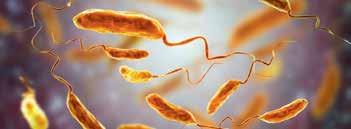


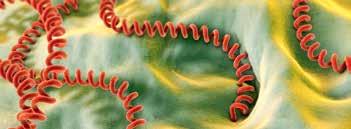
a) What microorganisms do the photographs show?
b) What type are they according to their shape?

2 Reading. Read the text ‘The importance of bacteria’ on anayaeducacion.es. In your notebook, copy only the correct statements from the list below.
a) All bacteria harm living beings or cause disease.
b) We use some types of bacteria to make dairy products.
c) Our gut microbiota is a collection of bacteria that lives in our intestines and helps them function properly.
d) A parasitic bacterium causes salmonellosis.
3 In your notebook, draw:
a) The stages of binary fission in bacteria.
b) The cell of a bacterium. Include the main structures.
4 Match each word to the correct definition: cyanobacteria, spirilla, saprophyte, symbiotic, flagella, binary fission, parasite.
a) Bacteria with an elongated spiral shape.
b) Bacteria which invade an organism and cause disease.
c) A type of asexual reproduction in bacteria.
d) Bacteria that perform photosynthesis.
e) The part of bacteria that allows movement.
f) Bacteria that obtain nutrition by decomposing the organic matter present in their environment.
g) Bacteria that live with another organism in an association.
5 Label the pictures with one of the following phrases.
a) A dairy product made with bacteria.
b) Foods unsuitable for consumption because of saprophytic bacteria.
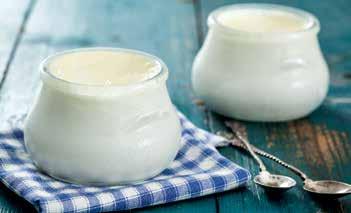

Vocabulary
Bacteria, cocci, bacilli, vibrio, spirillum, cyanobacteria, saprophyte, symbiotic, parasitic, flagella, colonies, binary fission, microbiota, decomposers, fermenting, salmonellosis, cholera, botulism, tetanus, cavities.
29 Unit 3
A C B D
A B
Protoctista and their importance 4

Protoctista and their types
Protoctista are eukaryotic living beings. Most of them are unicellular. Some are multicellular but their cells do not form tissues.
There are two types of Protoctista:
What are Protoctista? Why are they important?
What different types of Protoctista are there?
Are they all microscopic?
Why are they important for human beings?
PROTOZOA ALGAE
UNICELLULAR AND HETEROTROPHIC PROTOCTISTA (predators, saprophytes, parasites or symbiotic organisms)
According to how they move, they can be:
Ciliates
They have cilia on their surface (short filaments which they move in order to swim).
Flagellates


Rhizopods
They extend and contract their cytoplasm to form pseudopods. This allows them to move.
They have a large flagellum which they move in order to swim.


Sporozoans
These immobile parasites live inside other organisms.

Sexually (very few species)
They reproduce:

Fusion of gametes

Helpful
According to how complex they are, they can be:
Unicellular
They are unattached. This means that they are not fixed to form a surface. They move using flagella. They live in colonies.


UNICELLULAR OR MULTICELLULAR AUTOTROPHIC PROTOCTISTA (perform photosynthesis) Green
Filamentous
Their cells live attached to each other. They long, microscopic, fine filaments.

Multicellular
They are macroscopic. They don’t form tissues. They lived attached to the seabed or riverbed.


They reproduce


Asexually by binary fission

IMPORTANCE
• They purify wastewater when they feed on the bacteria present in it.
• They are a part of plankton. Other living beings feed on plankton.

Harmful
They cause disease in human beings:
• Malaria (caused by Plasmodium).
• Toxoplasmosis (caused by Toxoplasma).
Sexually Using gametes.





Asexually By binary fission (unicellular) By fragmentation or using spores (multicellular)
Fusion of gametes Red Brown





IMPORTANCE
Helpful
• They release oxygen into the air and the water when they perform photosynthesis.
• They are a food source. We also use them in animal feed, fertilisers and in agar (a thickening agent)...
Harmful
• Some are toxic and cause ‘red tides’ that harm aquatic organisms and human beings.
• They harm ecosystems if they grow excessively.
30
1 Name the two types of living beings that are part of Kingdom Protoctista.
2 Speaking. What type of Protoctista can you see in each of the photographs?
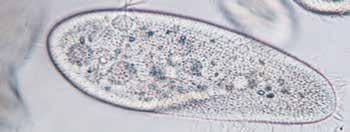



3 Write the names of the different types of protozoa according to how they move.

4 Reading. Read the text ‘The importance of protozoans’ on anayaeducacion.es. In your notebook, copy only the correct statements from the list below.
a) Which protozoan causes malaria?
b) Which animal transmits the malaria protozoan?
c) Which protozoan causes dysentery?
d) How the the protozoan that causes dysentery enter our body?
5 In your notebook, draw:
a) A ciliate.
b) A filamentous alga.
c) A macroscopic, multicellular alga.
d) A rhizopod.
6 Copy and complete the sentences in your notebook.
a) Protozoa exhibit … nutrition because they obtain … from other living beings or their remains.
b) … protozoa catch other unicellular organisms.
c) ... protozoa feed on the remains of other living beings.
d) ... protozoa live in the digestive tracts of other living beings and aid digestion.
e) … protozoa live in other organisms and cause disease.
7 Correct the following sentences in your notebook.
a) Algae are heterotrophic Protoctista.
b) All algae are unicellular.
c) Macroscopic algae are unicellular.
d) Macroscopic algae are plants.

8 Listening. Listen to ‘The importance of algae’ on anayaeducacion.es. Copy and complete the sentences in your notebook.
a) Algae ... the atmosphere and the water during the process of photosynthesis.
b) Many aquatic organisms … on algae.
c) Some algae are ... and can form … tides. These harm lots of aquatic organisms.
9 Match the words spore, binary fission, sexual and gametes to the following sentences.
a) This is the most common process of asexual reproduction in unicellular organisms that belong to Kingdom Protoctista.
b) This is a special cell that multicellular algae use to reproduce asexually.
c) These are cells that multicellular algae and some organisms in Kingdom Protoctista produce in order to reproduce sexually.
d) This type of reproduction takes place through gametes.
Vocabulary
Nutrition, interaction, reproduction, autotrophic, heterotrophic, organic, inorganic, oxygen, carbon dioxide, sexual, asexual, parent, offspring, gamete, fertilisation.
31 Unit 3
A C B D
Fungi and their importance 5

Fungi and types of fungi
Fungi are living beings. They have eukaryotic cells and a cell wall. They are heterotrophic. They can be unicellular or multicellular. They do not form tissues.
UNICELLULAR
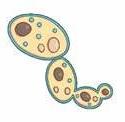
reproduction
By budding
What are fungi? Why are they important?
What different types of fungi are there?
Are they all microscopic?
Why are they important for human beings?
TYPES OF FUNGI (according to level of organisation)
MULTICELLULAR
Their cells form filaments called hyphae. A collection of hyphae is called mycelium.

Moulds Saprophytic or parasitic
Fungi that form mushrooms
Lichens

Asexual reproduction Using spores Saprophytic
Asexual reproduction Using spores
The importance of fungi
HELPFUL FUNGI
Decomposing fungi, such as those that live in soil, recycle the remains of organic matter in ecosystems.
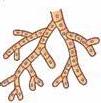
Fungi in the food industry. We use yeasts to make bread, wine and beer during the process of fermentation. We use some moulds to make cheese.

Edible fungi, Lots of mushrooms, such as truffles and saffron milk caps, are delicious to eat.


Fungi in medicines. Some moulds produce antibiotics. We use them to make medicines that cure bacterial infections.

Symbiotic
Live in association with algae
Asexual reproduction using spores

Alga Fungus
HARMFUL FUNGI
They spoil food. Mould decomposes food when it grows on it. This means the food is not safe to eat.

They are toxic. Some mushrooms and moulds are very toxic. They can cause poisoning if we consume them by accident.
They cause disease.
Some unicellular fungi and moulds can infect living beings. They then cause disease. For example:
• Ringworm, athlete’s food and allergic reactions to the spores of some moulds affect human beings.
• Some fungi infect plants and ruin harvests.
32
1 Write the terms for these definitions.
a) A filament formed by connected cells in a fungus.
b) The collection of hyphae in a fungus.
c) Unicellular fungi that reproduce by budding and which we use to make bread, wine and beer.
d) Multicellular filamentous fungi that spoil food when they grow on it.
2 Copy and complete the sentences in your notebook.
a) Fungi are ... because they obtain nutrients from living organisms or the remains of living organisms.
b) Fungi can be multicellular but their cells do not form ... .
c) Most fungi are ... that decompose or ferment the remains of living beings.
d) Some fungi are ... that live in other living organisms and cause disease.
3 Label the fungi in the pictures with the words yeast, mould, fungus that forms a mushroom and lichen.
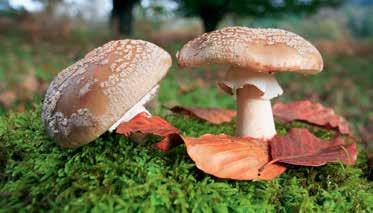


4 Listening. Listen to ‘Lichens’ on anayaeducacion.es. Copy and complete the sentences in your notebook.
a) A lichen is an association of two … organisms: a fungus and a unicellular … .
b) In a lichen, the ... provides protection and conserves humidity. The algae produces … through the process of ... .
c) Lichens live on ... , ... , etc.

5 Listening. Listen to ‘The importance of fungi’ on anayaeducacion.es. Write the name of three foods and drinks which are produced using fungi.
6 Speaking. Explain why these statements are false.
a) All mushrooms are edible.
b) Antibiotics are medicines that cure viruses.
c) We do not use yeasts for anything.
d) All moulds are dangerous because they spoil food and cause allergies.

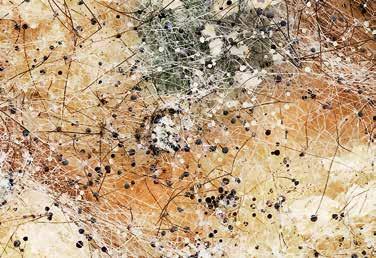
Vocabulary
Fungi, hyphae, filaments, mycelium, yeasts, moulds, mushrooms, lichens, budding algae, spores, decomposers, fermentation, edible, antibiotics, toxic, spoil, infection, ringworm, athlete’s foot, allergies.
33 Unit 3
A B C D
The final challenge
WRITE A MEDICAL REPORT
Get into groups of four. Your task is to identify the microorganism that is making your patient unwell.

STEP 1
Analyse the patient information
Physical characteristics:
• Male, 40 years old.
• Normal body size and in good physical shape.
Medical history:
• No diseases apart from occasional colds, throat infections and tooth infections.
• Up to date with all vaccinations, including for yellow fever.
• Just returned from the jungle in a tropical country. Has been taking antibiotics for several days for toothache.
STEP3
Consider different hypotheses
The patient’s symptoms may result from:
• A bacterial infection caused by something he ate or by drinking river water. Fever and diarrhoea are symptoms of this type of infection.
• An infection caused by the yellow fever virus, which is transmitted by mosquitos. It causes fever, abdominal pain and vomiting.
• An infection caused by amoebas when he drank contaminated water. It causes fever and diarrhoea.
• Loss of intestinal bacteria because of taking antibiotics. It causes diarrhoea.
Analyse the symptoms
What symptoms does he have?
• The patient has experienced frequent diarrhoea and stomach pain since they day he returned from the jungle.
• He has fever.
Other important information:
• During his trip he was bitten by mosquitos, ate local food and drank water from a stream.
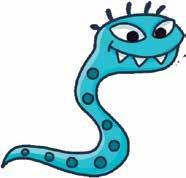
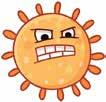

FINAL STEP STEP 2
Write your medical report

• Study all the information and do some research. Decide on your conclusion. Together, write a full medical report. Include your diagnosis and any recommended treatment.
34
SCAN THE CODE TO SEE THE GLOSSARY Take
action!
Contents 1. How is our planet 2. A planet full of life 3. Microorganisms 4. Plants 5. Invertebrates 6. Vertebrates 7. Ecosystems 8. We use the resources of the planet 9. Towards sustainable development
BIOLOGY AND GEOLOGY
DUAL
SECONDARY EDUCATION 1
FOCUS

The general characteristics of microorganisms
Microscopic
Smaller than 100 microns.

50 µm

Simple biological organisation

No cells

Unicellular


Multicellular (without tissues)
Varied vital functions
Autotrophic or heterotrophic


Mobile or immobile

Asexual or sexual reproduction

Adaptable, resistant and essential
VIRUSES


They are not living beings.
MONERA (bacteria)



They live everywhere. Helpful and harmful.
1 Name all the kingdoms of living organisms that contain microorganisms.

PROTOCTISTA FUNGI






Viruses
Characteristics
They are not living beings.
The genetic material is inside the capsid.
The capsid is made up of proteins.
Helical capsid

Spherical capsid


Icosahedral capsid
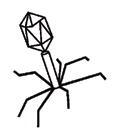
Icosahedral capsid with a tail
How they live
They are parasites.

They invade cells and destroy them.
Importance
They cause disease.
Common cold Flu
Hepatitis Rabies

2 What is the name for the protein shell that surrounds viruses? What is inside it?
8
MICROORGANISMS 3
Characteristics
Living beings
Unicellular and prokaryotic. Kingdom Monera
Genetic material
Cell wall
Membrane

According to their shape
AUTOTROPHIC
Nutrition
Interaction
Some interact by moving
Flagellum

Cyanobacteria
Cocci Bacilli Vibrios


Spirilla

HETEROTROPHIC
Saprophytes
Parasites

Symbiotic
3 What different types of heterotrophic bacteria are there?
The importance of bacteria
Helpful bacteria

They purify waste
They help us make

They oxygenate the air and water
Bacteria
How they live
Reproduction
Asexual by binary fission



Identical daughter cells
Harmful bacteria

They cause disease
They contaminate food
4 What type of bacteria:
a) Are in gut microbiota.
b) Help us to make dairy products.
c) Cause disease.
9
Protoctista
PROTOZOA ALGAE

Nucleus Membrane
Characteristics How they live How they live


Eukaryotic
Autotrophic nutrition

Unicellular Filamentous
Interaction


Predatory
Mainly asexual by binary fission nutrition
Saprophytic
Symbiotic
Parasitic



They are immobile
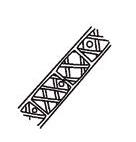
They live unattached (mobile)
They form colonies Cilia
Multicellular without tissues. Macroscopic

Green Red Brown
They lived attached
Reproduction
Sexual Asexual






Binary fission

Gametes Fragmentation


5 What are the main differences between protozoa and algae?
The importance of protoctista
Helpful protoctista
PROTOZOA
• They purify sewage.
• They form plankton.
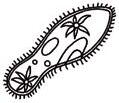


•
•
•

PROTOZOA
Harmful protoctista
Some cause diseases. ALGAE

• Toxic algae.
• They alter ecosystems if they grow excessively.

Give one example of how protozoa help us and how algae help us.
10 3
Fungi
Unicellular Eukaryotic with a cell wall.
Isolated cells
Yeasts

• Saprophytic heterotrophs.
• Reproduce asexually by budding.
Characteristics and how they live
Multicellular
Cells with a cell wall that form fine filaments (hyphae). The collection of hyphae is called mycelium. The cells do not form tissues.
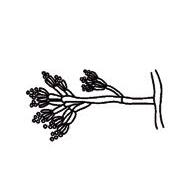
Fungi that form mushrooms
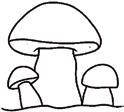
• Saprophytic heterotrophs. Reproduce asexually through spores.
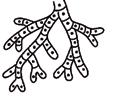
Lichens

• Symbiotic heterotrophs (with algae).
• Reproduce asexually through spores.
7 What three types of fungi are multicellular? Do they form tissues?
The importance of fungi

We use them to make foods and drinks
Bread, wine, beer, cheese




8 Which fungi can we eat?
9 Which fungi do we use to make bread?
10 Which fungi spoils food?
11 Which fungi can cause disease?
11
Helpful Harmful
Decomposers Edible They spoil food They affect our health Poisonous mushrooms Infections Allergies
© Text: NOMBRES COMPLETOS DE LOS AUTORES, 2024.
© This edition: GRUPO ANAYA, S. A., 2024–Valentín Beato, 21–28037 Madrid–ISBN: D. L.: Printed in Spain.
All rights reserved. No part of this publication may be reproduced, stored in a retrieval system, or transmitted, in any form or by any means, electronic, mechanical, photocopying, recording, or otherwise, without the prior permission of the publishers.













































































































































